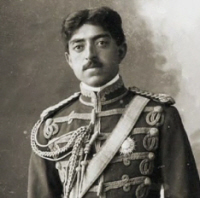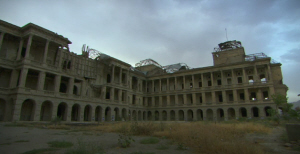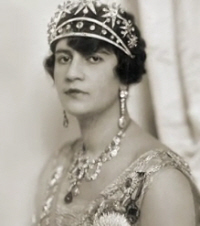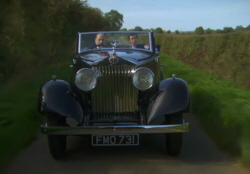King Abdur Rahman
The modernising King Amanullah
After decades of battling Russian influence in Afghanistan, the British Empire, at the peak of its power, bowed to Afghan realities and struck
a deal with their opponent. Just as in 1842, Britain again allowed the most powerful Afghan leader to take the throne, even though he was their enemy.
Abdur Rahman>
Abdur Rahman was an ally of the Russians and had been living on Russian soil, but he was the only man who seemed to have the support and authority
to control the country. It’s as though after 10 years of fighting the Taliban today, the United States and their allies left Afghanistan and put
the Taliban back in charge.
This extraordinary gamble paid off. For his part, the new king, Abdur Rahman, demanded a massive subsidy and no internal interference in his country.
In return, Britain got control of Afghan foreign policy and, most importantly, Abdur Rahman did not allow the Russians to threaten British India. For Britain,
it was a perfect solution.
And even when Europe descended into the First World War, Afghanistan remained neutral. But this would change in the aftermath of that Great War,
as the great powers of Europe met here in Versailles.
Here, empires were broken up, the new nation states were created, and Afghanistan, although excluded from the negotiating table, had its own ambitions.
For the first time, Afghanistan so often on the receiving end of British firepower, itself became the principal aggressor. The new king of
Afghanistan saw Britain exhausted by war, facing unrest in India. He called another jihad, took his chance and invaded British India through
the Khyber pass.
Although Britain saw off this unexpected aggression, they suffered twice as many casualties as the Afghans. But with Russia no longer the threat
of old, Britain saw less need for an interest in Afghanistan and granted the Afghans full independence. But what Afghanistan did with that independence
was the opposite of what the British expected.

King Amanullah

Extravagent Palace
The new king, Amanullah, revealed himself to be a moderniser. The British policy was really to keep Afghanistan locked in the middle ages. The
last thing they wanted was Afghanistan to change and modernise and then, suddenly, in 1919, modernity came. British ideas came to Afghanistan
against Britain’s will, and this great process of modernisation came not through the Empire, came not through British bayonets, but through
an Afghan king.
King Amanullah ruled from this extravagant palace in a European style, which he built on the outskirts of Kabul, and he championed a new
modernising intellectual elite in Afghanistan.
But the country that he was determined to transform had changed little in the century that had passed since Britain first took an interest here.
It was a country with almost blanket illiteracy, a fragmented country of isolated villages and mountain valleys under feudal rule, the way Britain
had found it and left it.
Dreaming of modernity, in 1927, Amanullah embarks on a grand European tour, the first such trip by an Afghan ruler. The Afghan king arrived in
Britain for a full state visit. The flags were out and a slightly anxious British government responded in came-honoured fashion by taking him to
shop for guns and for cars, which is impoverished country could hardly afford.
State Visit
And when he toured the Rolls-Royce factory, he bought a fleet of cars to take back home. It started a long love affair between Afghan royalty
and Rolls-Royce. And this car was later part of their fleet, now owned by businessman Richard Raynsford.
Rolls Royce
For an Afghan, possessing this car shows that you are part of an international group. You’re no longer part of an isolated country at the
other end of the world.
Richard Raynsford “Well, that’s right. He was a very sophisticated man. When he went to Europe in 1928, he was not just looking for Rolls-Royce
cars, he was looking, really, to… Means to be inspired by the West to how he could modernise his very backward country. And, therefore, the
Rolls-Royce trip to the Derby works was part of that overall quest for inspiration and for modernisation.”
A car like this at the time was a pretty expensive thing.
Richard Raynsford “It would cost as much as a house in Fulham. About £1500 for the chassis and another £1500, even more, up to £2000, for
the body, depending on how exotic a body was ordered by the excited owner.”

Richard Raynsford
What would an Afghan have felt, looking at this kind of car?
Richard Raynsford “It’d be like looking at something equivalent to the space shuttle, I imagine, to an Afghanistan farmer or peasant.”
I think it’s tempting today when we look at a car like this to imagine Amanullah as some sort of corrupt dictator who was spraying money
around on Rolls-Royces, but in fact, really, this is part of his love of technology or machinery. It’s as though he’s returning to the country
with a jet engine or a new computer system. He’s coming back with a whole new interests in railways and printing machines, and mining technology
and medicine, but for the Conservatives in Afghanistan, this is all very dangerous and very dubious. The big story that spreading through the
streets when he arrives is he’s bringing back a new machine to turn human corpses into soap.
Amanullah was just beginning to discover how conservative his country still was. Wild rumours were circulating
about how he had become a Catholic, ate pork and, drank alcohol. He became perceived as a foreigner in his own land, attempting to impose a
foreign ideology on his own people.
It’s easy to laugh at Amanullah and, indeed, there’s a lot that you can laugh at him for. For example, he gathered the tribal elders and
insisted they wore pinstripe trousers and western jackets, but there was also a highly developed serious programme of reform.

Amanullah’s Queen
In fact, the most radical programme for state transformation in Afghanistan came from an Afghan. He wanted parliamentary elections,
a progressive constitution, education, particularly for women. And, in the end, when photographs were circulated in the bazaar of his
wife the Queen, with her head uncovered, with pearls and a plunging neckline, he had to flee, with the wheels of the Rolls-Royce
spinning vainly in the snow, to exile in Italy.
It is ironic, when, today, we are concerned with the powerful hold of Islam and the problems of establishing democracy in that country,
that the only attempt in this whole period to modernise and democratise Afghanistan didn’t come from British rule, but from the Afghans themselves.
So why did the British go into Afghanistan in the 19th century?
It wasn’t really about Afghanistan in the end. It was about the fears of empire, fear of empty space, fear of the Russians, fear in
the end about their own credibility, their pride.




